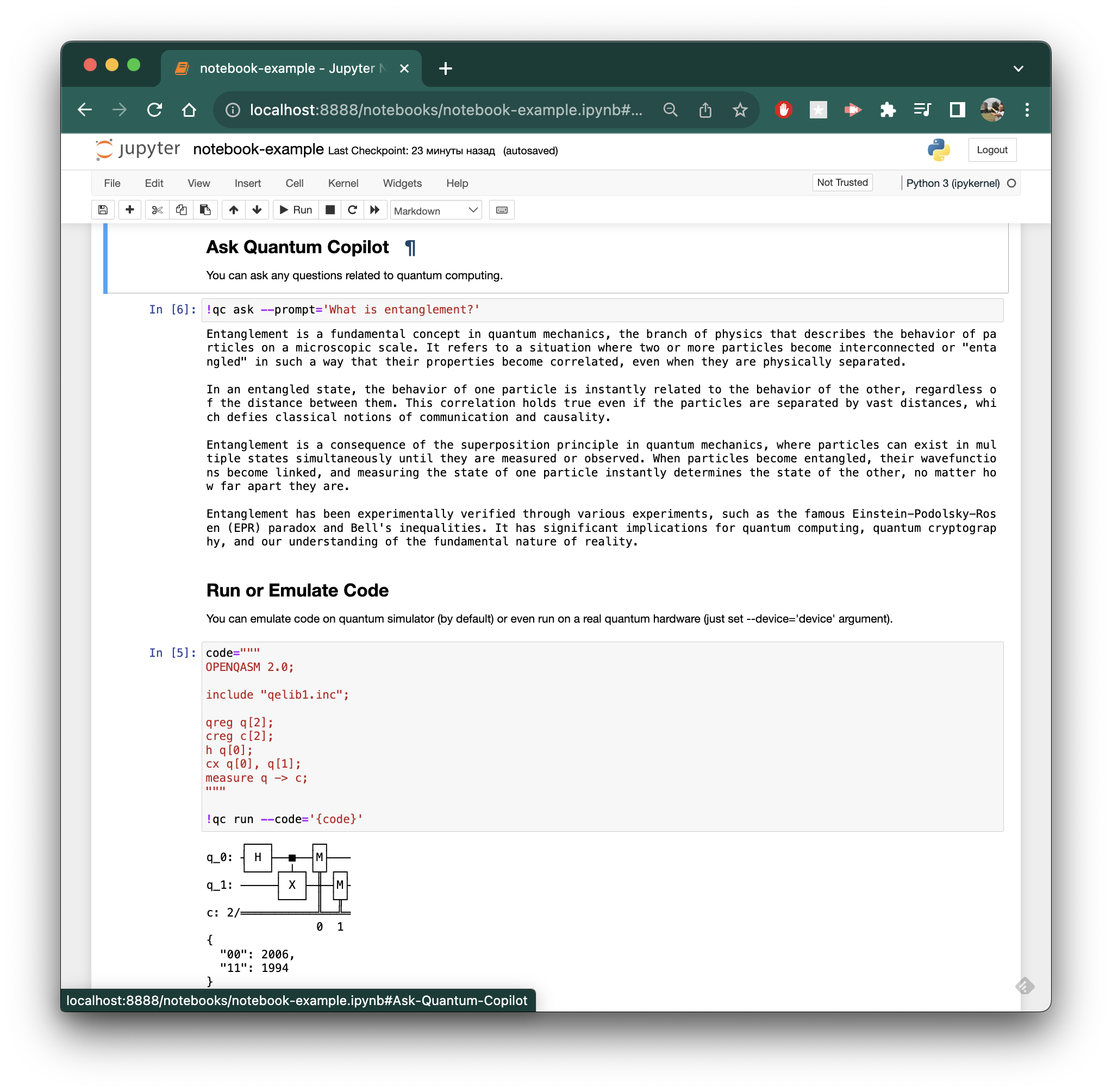@vuics/qcopilot-js v1.0.12
qcopilot-js
The qcopilot-js is a command line tool for interacting with the Quantum Copilot API.
You can read the API.md document to learn more about the Quantum Copilot API.
Install
You can install the package from NPM globally:
npm i -g @vuics/qcopilot-jsOr install locally from the repo:
npm iSetup
Create an API key on Quantum Copilot.
Create .env file with the following content:
QCOPILOT_API_URL=https://api.qc.vuics.com/v1
QCOPILOT_API_KEY=<GET_API_KEY_ON_QUANTUM_COPILOT>Run
To run:
qc
qc helpUsage Examples
Ask
Ask a question and get an answer.
qc ask --prompt='What is a qubit?'Example output:
A qubit, short for "quantum bit," is the basic unit of quantum information in quantum computing and quantum information theory. Similar to the classical binary bit, which can represent either a 0 or a 1, a qubit can represent a 0, a 1, or both simultaneously thanks to a property called superposition. This is due to a quantum mechanical phenomenon known as quantum superposition.
The most common physical representation of a qubit is using the spin of an electron or the polarization of a photon. In the case of an electron, its spin can be either "up" or "down," which corresponds to the classical binary states 0 and 1. However, a qubit can exist in a superposition of both states simultaneously, allowing for more complex computational possibilities.
Furthermore, qubits can also exhibit another quantum phenomenon called entanglement. Entanglement allows for a strong correlation between qubits, even if they are physically separated, enabling certain operations on one qubit to affect the state of another qubit instantly.
Qubits form the foundation of quantum computing and hold the potential to perform complex calculations exponentially faster than classical computers, leading to advancements in fields such as cryptography, optimization, and simulation.Run
Run a code on a quantum simulator or a real quantum hardware.
qc run --code='OPENQASM 2.0; include "qelib1.inc"; qreg q[2]; creg c[2]; h q[0]; cx q[0], q[1]; measure q -> c;' --device='simulator_statevector'Example output:
┌───┐ ┌─┐
q_0: ┤ H ├──■──┤M├───
└───┘┌─┴─┐└╥┘┌─┐
q_1: ─────┤ X ├─╫─┤M├
└───┘ ║ └╥┘
c: 2/═══════════╩══╩═
0 1
{
"00": 2040,
"11": 1960
}By default, it runs code on a quantum simulator but you can set real quantum harware, for instance --device='ibmq_quito'.
qc run --code='OPENQASM 2.0; include "qelib1.inc"; qreg q[2]; creg c[2]; h q[0]; cx q[0], q[1]; measure q -> c;' --device='ibmq_quito'Code-run
Generate code and run it on a quantum simulator.
qc code-run --prompt='Write me a code example of quantum cirquit algorithm on OpenQASM 2'Example output:
OPENQASM 2.0;
include "qelib1.inc";
qreg q[2];
creg c[2];
// Applying a Hadamard gate to the first qubit
h q[0];
// Applying a controlled-X gate to entangle the qubits
cx q[0], q[1];
// Measuring the qubits
measure q[0] -> c[0];
measure q[1] -> c[1];
┌───┐ ┌─┐
q_0: ┤ H ├──■──┤M├───
└───┘┌─┴─┐└╥┘┌─┐
q_1: ─────┤ X ├─╫─┤M├
└───┘ ║ └╥┘
c: 2/═══════════╩══╩═
0 1
{
"11": 2025,
"00": 1975
}Use in Jupyter Notebook
It is possible to use the qcopilot-js directly from your Jupyter Notebooks. See the notebook-example.ipynb for more information.
